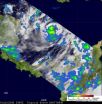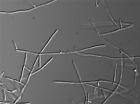(Press-News.org) An instrument on NASA's Aqua satellite noticed increasing colder cloud top temperatures of tropical depression 15 in the south-central Caribbean just before it strengthened into Tropical Storm Matthew late on Sept. 23. The TRMM satellite also spotted heavy rainfall within the system. Matthew is now headed to the western Caribbean and watches and warnings are in place as Matthew may continue to strengthen.
Cloud top temperatures indicate the strength of the storm to forecasters. The colder the cloud top temperatures, the stronger the convection and uplift. When cloud top temperatures drop, as they did in Atmospheric Infrared Sounder (AIRS) imagery captured on Sept. 23 at18:53 UTC (2:53 p.m. EDT) it indicates the storm is gaining strength. At that time, Matthew's maximum sustained winds were near 40 mph. In the image, the coldest cloud top temperatures (colder than -63 Fahrenheit) appeared around the center of Matthew's circulation already giving the appearance of an eye. The AIRS infrared image on Sept. 24 at 3:05 a.m. EDT showed a concentrated area of strong thunderstorms around Matthew's center as the sustained winds had increased to 50 mph.
AIRS has the ability to determine cloud top and sea surface temperatures from its position in space aboard NASA's Aqua satellite. Cloud top temperatures help forecasters know if a storm is powering up or powering down and Matthew is powering up.
In addition to the Aqua satellite, the Tropical Rainfall Measuring Mission (TRMM) satellite flew nearly above Matthews's location on Sep. 24 at 0159 UTC (9:59 p.m. EDT Sept. 23) capturing data used in a rainfall analysis done at NASA's Goddard Space Flight Center in Greenbelt, Md. TRMM Microwave Imager (TMI) data analyzed from this orbit showed moderate to heavy rainfall southwest of MATTHEW's center of circulation.
At 11 a.m. EDT on Sept. 24, Matthew's maximum sustained winds were near 50 mph, and strengthening is expected in the warm Caribbean waters, so the National Hurricane Center said that Matthew could become a hurricane by Saturday. Meanwhile at 11 a.m. Sept. 24, Matthew was located about 80 miles east of Cabo Gracias a Dios, Nicaragua, near 14.4 North and 82.2 West. It was moving west at 20 mph, and had a minimum central pressure of 1001 millibars. Just 15 hours before, its minimum central pressure was 1005 millibars, and a drop in pressure indicates a strengthening storm.
A hurricane watch is in effect for Puerto Cabezas, Nicaragua to Limon, Honduras including the offshore islands. A tropical storm warning is in effect for Puerto Cabezas, Nicaragua to Limon, Honduras including the offshore islands.
A tropical storm warning is in effect for Puerto Cabezas, Nicaragua northward to the border with Honduras including the offshore islands and the coast of Honduras including the offshore islands. A tropical storm watch is in effect for the coast of Belize, while a hurricane watch is in effect for Puerto Cabezas, Nicaragua to Limon, Honduras. Hurricane conditions are possible between 11 p.m. EDT tonight and 11 a.m. EDT Saturday in that watch area.
Tropical storm-force winds are expected to reach the coastal warning areas during the afternoon of Sept. 24, and a storm surge is expected to produce flooding and dangerous surf. Expected rainfall amounts of 6 to 10 inches are forecast with isolated amounts to 15 inches.
According to the National Hurricane Center in Miami, on the forecast track the center of the Matthew is expected to be near the Nicaragua/Honduras border late Friday or early Saturday morning then move over land in northern Honduras on Saturday. Updates on Matthew can be found at the National Hurricane Center's web page: www.nhc.noaa.gov.
INFORMATION:
NASA satellites see Tropical Storm Matthew grow quickly, warnings up in Central America
2010-09-25
ELSE PRESS RELEASES FROM THIS DATE:
NASA's CloudSat satellite sees a powerful heat engine in Typhoon Malakas
2010-09-25
Towering thunderstorms and heavy rainfall are two things that NASA's CloudSat satellite saw as it passed over Typhoon Malakas, and those two factors confirm a strong storm. NASA's CloudSat satellite's Cloud Profiling Radar can basically slice a tropical cyclone in half and take a look at its clouds and rainfall, and that's what it did when it passed over Typhoon Malakas on Sept. 23.
CloudSat flew over Typhoon Malakas during the daytime on Sept. 23. At that time, Malakas had a minimum central pressure of 965 millibars, maximum winds of around 115 mph (100 knots), and ...
GOES-13 Satellite sees Lisa a tropical storm...for now
2010-09-25
The GOES-13 satellite has been keeping an eye on Tropical Storm Lisa and watched her birth, graduation to depression then tropical storm and back to depression. Now, Lisa has grown back to tropical storm status, but it may be short-lived.
At 11 a.m. EDT on Friday, Sept. 24, Tropical Storm Lisa had maximum sustained winds near 50 mph and she may strengthen and weaken over the weekend, but by Sunday colder waters will zap her energy source and she is forecast to be a depression.
Meanwhile, on Sept. 24, she was still frolicking in the eastern Atlantic, about 320 miles ...
The psychology of financial decision-making and economic crises
2010-09-24
How could the current financial crisis have happened? While fingers have been pointing to greedy banks, subprime-loan officers, and sloppy credit card practices, these are not the only contributors to the economic downturn. A new report in Psychological Science in the Public Interest, a journal of the Association for Psychological Science, examines the psychology of financial decision making, including the role of risk in making economic choices, how individuals behave in stock and credit markets, and how financial crises impact people's well-being.
Risk taking is a ...
Microbiologists find source of fungus's damaging growth
2010-09-24
SAN ANTONIO, Texas, U.S.A. (Sept. 22, 2010) – Candida albicans, a fungus that kills more than 10,000 people with weakened immune systems each year, grows more dangerous as it forms and extends long strands of cells called hyphal filaments. In a paper published this month, UT Health Science Center San Antonio microbiologists describe a key factor involved in this damaging growth.
This finding may eventually lead to targets for antifungal strategies, the scientists said.
Patricia Carlisle, a Ph.D. student at the Health Science Center, and David Kadosh, Ph.D., assistant ...
Could brain abnormalities cause antisocial behavior and drug abuse in boys?
2010-09-24
AURORA, Colo (Sept. 22, 2010) Antisocial boys who abuse drugs, break laws, and act recklessly are not just "bad" kids. Many of these boys may have malfunctioning brains, according to a new study by researchers at the University of Colorado School of Medicine.
"Brain responses to everyday rewards and punishments gradually guide most youngsters' decisions to conform with society's rules. However, when these seriously troubled kids experience rewards and punishments, and make decisions, their brains apparently malfunction," said Thomas Crowley, MD, a professor of Psychiatry ...
Clinical trial establishes catheter-based aortic valve replacement as new standard of care for patients
2010-09-24
WASHINGTON, DC (September 22, 2010) -- One-year data from the PARTNER clinical trial, published today in the New England Journal of Medicine, demonstrate that transcatheter aortic-valve implantation, compared with standard therapy, resulted in significantly lower rates of death among patients who cannot undergo surgery for aortic stenosis. The results will be presented tomorrow as a Late Breaking Trial at the 22nd annual Transcatheter Cardiovascular Therapeutics (TCT) scientific symposium.
Transcatheter aortic-valve implantation (TAVI) is a new procedure in which a bioprosthetic ...
Coral bleaching likely in Caribbean this year
2010-09-24
According to the NOAA Coral Reef Watch monitoring system, coral bleaching is likely in the Caribbean in 2010. With temperatures above-average all year, NOAA's models show a strong potential for bleaching in the southern and southeastern Caribbean through October that could be as severe as in 2005 when over 80 percent of corals bleached and over 40 percent died at many sites across the Caribbean. Scientists are already reporting coral bleaching at several Caribbean sites and severe bleaching has been reported from other parts of the world.
The NOAA Coral Reef Watch (CRW) ...
Acute pain is eased with the touch of a hand
2010-09-24
There may be a very good reason that people naturally clutch their hand after receiving an injury. A new report published online on September 23 in Current Biology shows that self-touch offers significant relief for acute pain under experimental conditions. The researchers suggest that the relief comes from a change in the brain's representation of the rest of the body.
"Pain is quite an important, but also complicated, experience and can be caused in many different ways," said Patrick Haggard of University College London. "We show that levels of acute pain depend not ...
Imaging study provides new view of multiple sclerosis
2010-09-24
Scientists have uncovered an alternative source for some of the damage associated with multiple sclerosis (MS), an incurable neuroinflammatory disorder. The research, published online by Cell Press on September 23rd in the journal Immunity, reveals a direct interaction between immune cells and neurons that plays a significant role in neuronal injury and may respond to therapeutic intervention.
MS is an autoimmune disease in which a person's own immune system attacks their central nervous system. Symptoms of MS are variable depending on which nerves are affected, but often ...
African-Americans face kidney disease-related disparities according to 2 new studies
2010-09-24
1. Among HIV-Infected Kidney Disease Patients, African Americans are More Likely to Develop Kidney Failure and Die Prematurely
Washington, DC (September 17, 2010) — Because of improved antiretroviral therapies in recent years, HIV-infected individuals are living long enough to develop chronic conditions. Among African Americans, HIV infection is increasingly recognized as an important risk factor for developing chronic kidney disease. African American men and women are more likely to die from the complications of HIV infection compared with Caucasian men and women. To ...



